15 Unique Forest Creatures Less Known To Man
Many people look to science fiction movies to find weird and fascinating
creatures, when they really could look right here on Earth. There are dozens of
weird creatures to be seen, from the horned unicorn of the sea, the Narwhal, or
the strange beast of the African plains, the Striped Cheetah. These creatures
fascinate and enthrall people, and sometimes even tempt people into poaching the
animals for money. For this reason, there are many forest creatures that are
either almost extinct or so elusive that most people don't even know they exist.
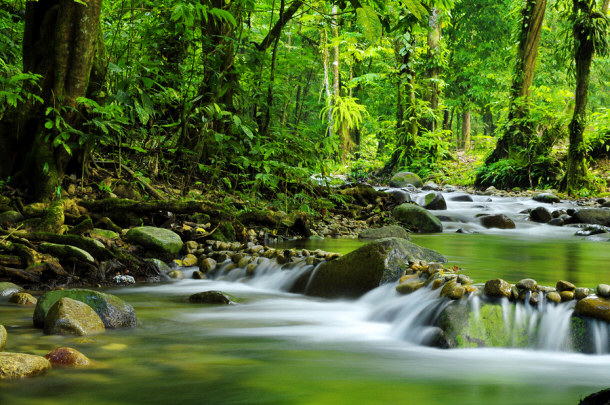
15) The Smelly Musk Deer
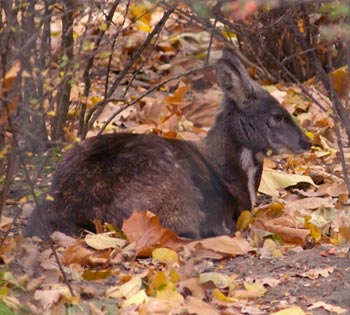 If you've ever had any type of perfume or cologne, you
have used musk. Musk is a strong-smelling secretion produced by the glands of
the Asian musk deer. Musk from this odd looking deer has been used in not only
perfumes, but also in traditional Chinese medicines for more than 5,000 years.
Musk is used in approximately 400 Chinese and Korean traditional remedies, which
makes it one of the most used and most valuable animal related medicinal
products. The online Encyclopedia says the Moschidae (or musk-deer) are characterized by skeletal specializations for
jumping like they are on a pogo stick, the male deer's inguinal scent pouches
and the large, curved and slightly movable canine teeth. They do not have
antlers. There are currently only six living species of the deer. A unique
quality of the deer is that they have very long legs and rather large, thick
ears. The deer is found in China, Siberia, and the Himalayas. Recent studies suggest that the deer is almost extinct because
of over poaching for the deer's musk. 17,000 to 20,000 musk deer stags are
killed each year, according to the World Wildlife Federation. If you've ever had any type of perfume or cologne, you
have used musk. Musk is a strong-smelling secretion produced by the glands of
the Asian musk deer. Musk from this odd looking deer has been used in not only
perfumes, but also in traditional Chinese medicines for more than 5,000 years.
Musk is used in approximately 400 Chinese and Korean traditional remedies, which
makes it one of the most used and most valuable animal related medicinal
products. The online Encyclopedia says the Moschidae (or musk-deer) are characterized by skeletal specializations for
jumping like they are on a pogo stick, the male deer's inguinal scent pouches
and the large, curved and slightly movable canine teeth. They do not have
antlers. There are currently only six living species of the deer. A unique
quality of the deer is that they have very long legs and rather large, thick
ears. The deer is found in China, Siberia, and the Himalayas. Recent studies suggest that the deer is almost extinct because
of over poaching for the deer's musk. 17,000 to 20,000 musk deer stags are
killed each year, according to the World Wildlife Federation.
14) The Small Fairy Armadillo
The Pink Fairy Armadillo (also known as Pichiciego)
is the smallest of the armadillos. Its body,
excluding tail, is roughly three to four inches long. It is pale red or even
pink in colors, and is generally found in central Argentina. It inhabits forests
at times, but mostly is found in dry grassy areas and on sandy stretches. One of
the most unique features of this creature is that it will bury itself in the
sand in just a few moments if it is scared or feels threatened by another
animal. It feeds mainly on ants, so it burrows holes near colonies to eat them.
It has also been known to feed on snails, plants, insects, root material and
worms.
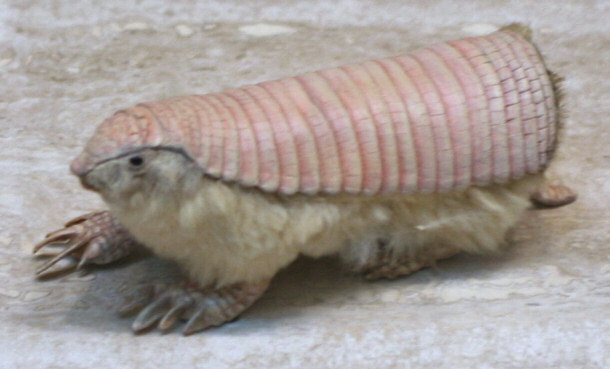
The shell is held in place by two large, rough features in the bone above the
eyes and a narrow ridge of flesh along the spine.
Like all armadillos, the flesh on the belly, the legs, and the parts of the body
not protected by the shell are covered in white hairs and soft. The bands of the
shell move individually. The tail, which can be one to two inches in length,
cannot be raised and must drag the ground. Other than when burrowing, the Fairy
Armadillo is quite slow and sluggish. If in captivity, the animal dies quickly,
with the longest known captive armadillo only living four years. The Fairy
Armadillo is classified as endangered, and its number one predator is domestic
dogs.
13) The Raccoon Dog
The Raccoon Dog is a small species of canine with markings that resemble that of
a raccoon. It is native to Eastern Asia and
lives in the forest. It has been known to even act like a raccoon, and washes
its food before eating it. The dog is now found in Japan and Europe, where it
was introduced to expand its habitat because over hunting and deforestation in Asian countries has made it extinct in certain parts. These
dogs are rare in that they are the only dog-like mammal that hibernates through
the winter, like a bear. Their hibernation is not fully like bears, in that they
do not sleep through the whole winter, but they can sleep through a snow storm
to survive the winter when food is scarce.
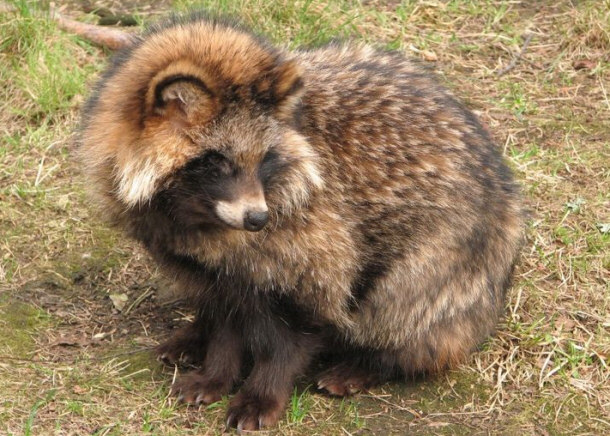
By Jukka A. Lång,
via Wikimedia Commons
A-Z Animals says there are five different species of raccoon dog and all are
known to have dexterous front paws that allow them to catch slippery food in the
water and climb trees. These dogs are carnivorous and spend most of their time
close to water, which means their diet is made up from frogs, fish, small birds,
eggs, insects, and even spiders. The main predator for this dog is the wolf, but
foxes, wildcats, and humans all come in a close second. A small island in Japan
has been designated a protected area for raccoon dogs.
These dogs can live for about 10 years in captivity, and they live in a family
of about five to eight other dogs. They can have litters of six to eight pups,
which are totally blind when they are born.
12) The Sun Bear
The Sun Bear (Helarctos malayanus) is a bear found in the
tropical rainforests of Southeast Asia. It stands approximately 4 feet in length
and weighs less than 145 pounds, making it the smallest in the bear family. It is sometimes referred to as the dog bear
because of its small size. Like most species the males tend to be somewhat
larger than females. Another reason it is known as the dog bear is because its
fur is short and sleek, unlike other members of the bear family. Scientists
believe this difference in fur quality is likely due to the climates where sun
bears generally live. Its coat is a dark black or brown-black with pale orange
or yellow fur on the chest, like a sun patch in the shape of a horseshoe. This
is where the bear's name is derived from. They have smaller ears than most
bears, but they have excellent hearing. Their feet turn inward, giving them a
pigeon-toed type walk.
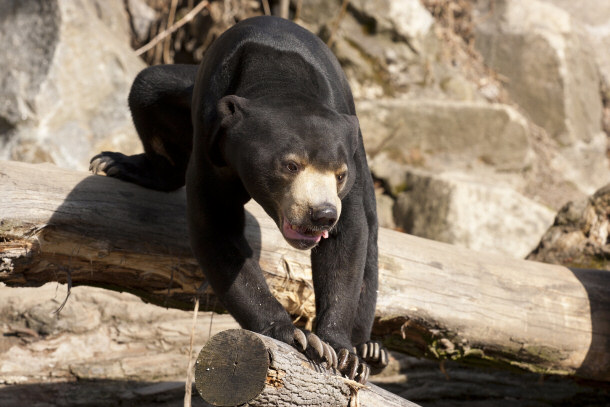
The Sun Bear is one of the rarest bears in the world, which makes it the
least known. These rare creatures spend their
days sunbathing and lazing on platforms they build in trees. Their habitats grow
to only the size of the space that holds enough food for them. If food is
plentiful, they won't roam much. If it is not, they'll spread their territory.
Compared to other bears, the Sun Bear has flatter teeth and a longer tongue.
This helps them get honey and insets from trees. Interestingly for these tree
dwellers, the bear's age can be determined by the rings on their teeth like a
tree's age is determined by the rings on its trunk. This little bear is
extremely aggressive and will attack without provocation or warning. This may be
a way to protect their young, who (at birth) are blind, hairless, and very tiny
with almost transparent skin. The bears have been on the endangered species list
since 1978.
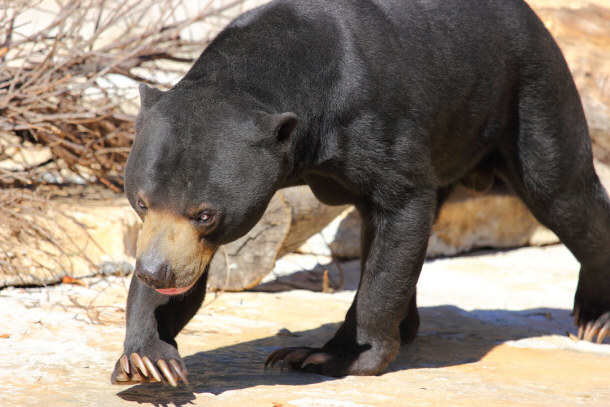
11) The Very Hairy
Red Panda
 The Ailurus fulgens, the shining cat, the red fox,
is slightly larger than a domestic cat and herbivorous. It's known as the Red
Panda, and it has semi-retractile claws and a "false
thumb." The animal has thick fur on the soles of the feet to hide scent glands
and protect the animal from the cold. This native of the Himalayas and southern
China eats mostly bamboo, fruit, plants, and some insects, just like the Giant
Panda. Unlike the Giant Panda, the Red Panda eats the whole bamboo plant, except
the roots, and chews it slowly. Unfortunately for pandas, bamboo goes through
the digestive tract quickly, so the animal must eat lots of it to sustain
itself. These animals can spend up to 13 hours a day looking for food, even
though their metabolism is low and they are covered in fur to conserve body
heat. The Ailurus fulgens, the shining cat, the red fox,
is slightly larger than a domestic cat and herbivorous. It's known as the Red
Panda, and it has semi-retractile claws and a "false
thumb." The animal has thick fur on the soles of the feet to hide scent glands
and protect the animal from the cold. This native of the Himalayas and southern
China eats mostly bamboo, fruit, plants, and some insects, just like the Giant
Panda. Unlike the Giant Panda, the Red Panda eats the whole bamboo plant, except
the roots, and chews it slowly. Unfortunately for pandas, bamboo goes through
the digestive tract quickly, so the animal must eat lots of it to sustain
itself. These animals can spend up to 13 hours a day looking for food, even
though their metabolism is low and they are covered in fur to conserve body
heat.
The "lesser," smaller panda was actually discovered 50 years before the Giant
Panda and gave the more known panda its name. This bear has been classified into two species, the bear and the
raccoon. The head and body length averages 22 to 25 inches, and the tails are
about 15 to 19 inches. Pandas have a home range of one to three miles, with
females on the one-mile side and males on the three mile side. They mark their
territory with urine, anal gland secretions, and scents from foot glands. These
animals communicate through latrine sites, body language, and noises.
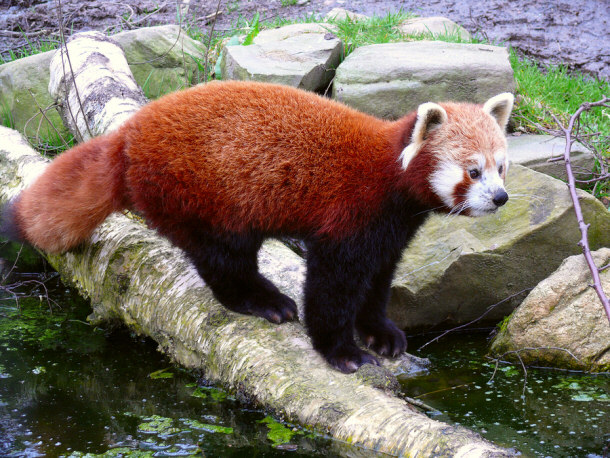
10) The Emperor Tamarin and His Majestic Beard
The Emperor Tamarin (Saguinus
imperator) is supposedly named for its uncanny resemblance to the German emperor
Wilhelm II. At first the name was to be a joke, but it has stuck and is now the
official scientific name. This unique tamarin lives in the
Amazon basin, Peru, Bolivia, and Brazilian states. The Emperor Tamarin has
predominantly grey colored fur with specks of yellow on its chest. The hands and feet of the animal are black and its
tail is brown. It's defining feature, though, is its long, white mustache, which
falls below the shoulders on both sides of its face. They have non-grasping
tails and long nails that help them climb. These animals are small, but feisty.
They can live up to 20 years, with the mature females leading the group. They
have family groups in 25-100 acre plots and are extremely aggressive and
territorial. They sleep in tree holes and during the day they groom each other,
communicating with eyelids and shrill screams.
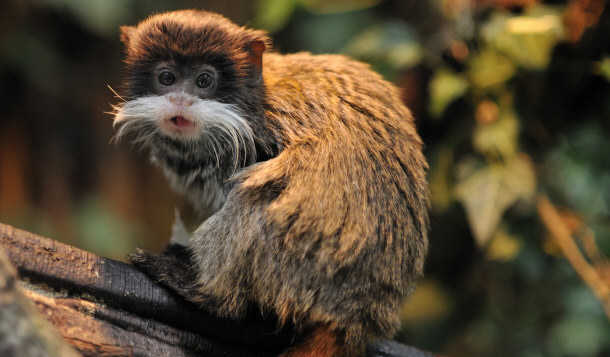
9) The Long-Nosed Monkey
The Nasalis larvatus, or the Long-nosed Monkey, is
quite funny to look at and definitely stands out. This "Old World monkey" is
reddish-brown and the only species in monotypic genus Nasalis. Adults have pink faces, but younger monkeys have a blue face until around
three years of age. The animal's feet are partially webbed. The monkey derives
its name from its most astounding feature, the male's large protruding nose.
Scientist have not been able to determine the purpose of the large nose, but
some suggest it's a result of sexual selection. The female Proboscis Monkey
prefers the big noses, and the bigger the better. Males can reach 28 inches in
length and may weigh a little more than 50 pounds. Females generally are half
that weight.
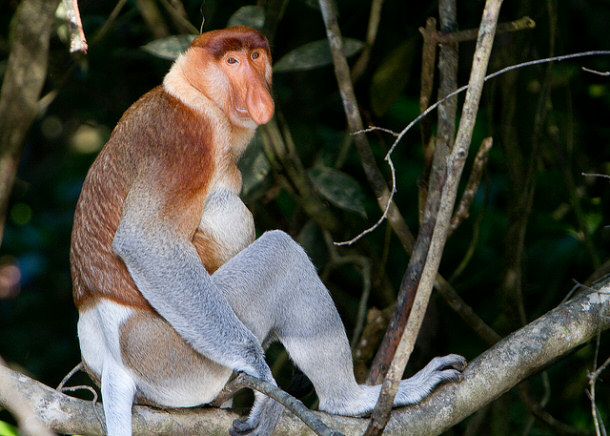
Another odd feature of this monkey is its large belly, found in both the
males and females. This is a result of its diet and how its digestive tract
handles so much plant intake. The process releases a lot
of gas, which makes the monkey constantly bloated. This makes the creature
unable to digest ripe fruits. They live in Bornea in the swamp forests, and
often dine on insects, leaves, seeds, and rotten fruit. Sometimes they have
small animals for food. These monkeys can live for 13 years. Typically they live
in troops, with four to twenty members. They generally do not have more than one
male in a group of females, but they can have all male groups. They are expert
swimmers and will dive into water if frightened. They are not territorial. They
are considered an endangered species.
8) The Ugly Aye-Aye
It's a creature that was surely used as the muse for the
movie "Gremlins" and not for the cute fluffy animal... no, more so for the ugly
creatures that are born from giving the fluffy one water after midnight. It's
ugly, but it's fascinating. The Aye-aye (Daubentonia madagascariensis) calls
Madagascar its home, says Nat Geo, and it combines teeth like a rodent with a
thin and long "finger" to dig bugs out of trees. Think about a woodpecker, but
with a finger. This creature taps on trees to find grubs, gnaws holes in the
wood to create an opening for its finger, then it uses that finger to pull the
grubs out. The Aye-aye has the special distinction of being the world's largest
nocturnal primate.
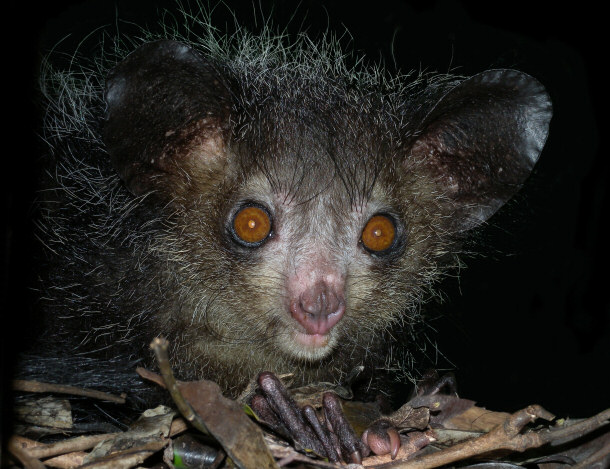
Aye-ayes are the only primate thought to use echolocation in their feeding
process. To mate, they hang upside down on a branch for
roughly an hour. These creatures look like a lemur in structure, since it is
closely related to the animal, but it has far less hair and much larger eyes.
It's generally dark grey to black in color, and has tufts of white or grey hair
around the ears. It's small, like a lemur, but it's ears and eyes are
disproportionate to its head. Its eyes are a deep yellow or golden color.
7) The Endangered Tarsier
Tarsiers have extremely large eyes and very long feet that boast elongated
tarsus bones, which is how these primates got their name. These animals
primarily feast on insects that they catch by jumping at them, much like a cat
pouncing. They have been known to
prey on birds and snakes, which they can catch in motion. These animals are
nocturnal, but do not have a light reflecting area of the eye, like many other
nocturnal animals do. These primates are only found in the islands of Southeast
Asia. They are born with fur and
their eyes fully open and operational, and they are able to climb trees within
an hour of being born. They have different colored fur, depending on the type of
Tarsier, and flat noses. They are an endangered species and do not do well in
captivity, many times committing suicide when caught because of stress.
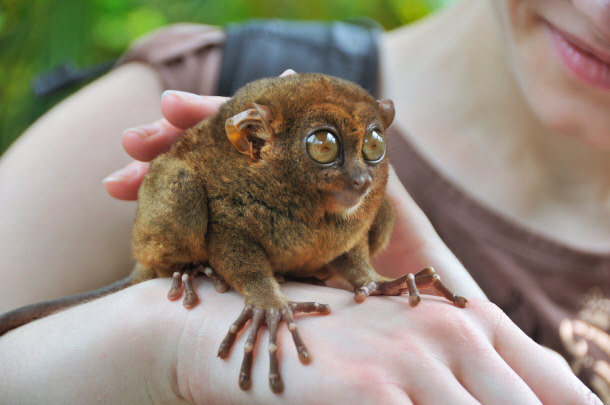
Great small climbers:
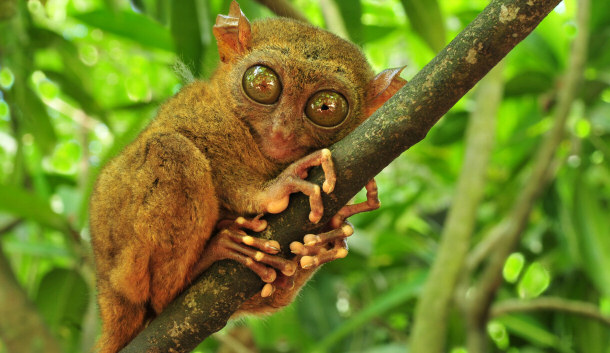
6) The Kinkajou
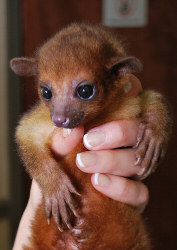 The Kinkajou is a relative of the raccoon. It has golden fur and
looks a bit like a monkey, but it's more closely related to the raccoon. It's a
tree dweller that has a tail that can grip branches. This tail is used for
snuggling and is almost as long as the animal's body. This animal is also called
a honey bear. It has a five inch-long tongue that it uses
to grasp fruit and lick nectar from flowers, as well as honey from hives and sap
from trees. Sometimes they will eat eggs, insects, small vertebrates, and even
hatchlings. The San Diego Zoo says the mammal is in rain forests in areas
ranging from Mexico to Brazil. Like bees, these animals go from flower to flower
for nectar and pollinate as they go. The Kinkajou is a relative of the raccoon. It has golden fur and
looks a bit like a monkey, but it's more closely related to the raccoon. It's a
tree dweller that has a tail that can grip branches. This tail is used for
snuggling and is almost as long as the animal's body. This animal is also called
a honey bear. It has a five inch-long tongue that it uses
to grasp fruit and lick nectar from flowers, as well as honey from hives and sap
from trees. Sometimes they will eat eggs, insects, small vertebrates, and even
hatchlings. The San Diego Zoo says the mammal is in rain forests in areas
ranging from Mexico to Brazil. Like bees, these animals go from flower to flower
for nectar and pollinate as they go.
Kinkajous are very loud and vocal animals, with high-pitched screeches that
sound like a woman screaming. They also bark much like a small dog. The little
creatures mark their territory with scent glands from their mouth, throat, and
stomach. These animals are not considered endangered yet, and they are hard to
find since they spend most of their time in the canopies of the forests, but
there has been evidence of over poaching and capturing the animals for the
exotic pet trade. Kinkajous are not good in captivity and have a painful bite,
which they will use if cornered. They can also be very destructive to homes.
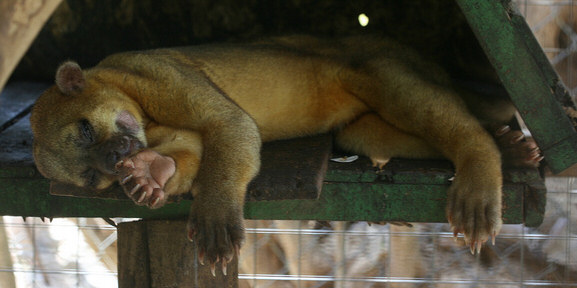
5) Poison Dart Frog
The poison Dart Frog is exactly what it sounds like - a
poisonous dart frog! These brightly colored frogs are one of the most toxic
creatures on the planet, according to National Geographic. Their bright colors
(varying in red, orange, yellow, blue, green, and even purple and pink) are
actually a way to warn predators that the frog is poisonous. Talk about being
kind to potential enemies. There are many species of this frog and some are so
potent that even touching it slightly can deliver a lethal amount of toxins. The
frog derived its name from native tribes that dip the end of darts on the frog's
skin or in its blood to extract its poison and use it for hunting or on enemy
tribes. Scientists call these amphibians "poison frogs" simply because not all
are used to tip darts in toxins by native tribes. Rain Forest Animals says the
frog is native to South and Central America. They feed on crickets, fleas,
termites, and ants. They live in forest streams, rivers, marshes, and swamps and
can grow to be four inches long, depending on the species.
These Poison Dart Frogs Represent Uniquely Gorgeous Colors:
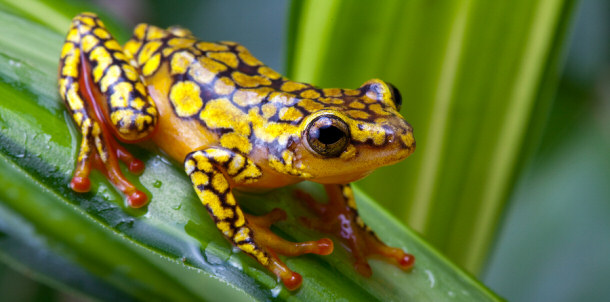
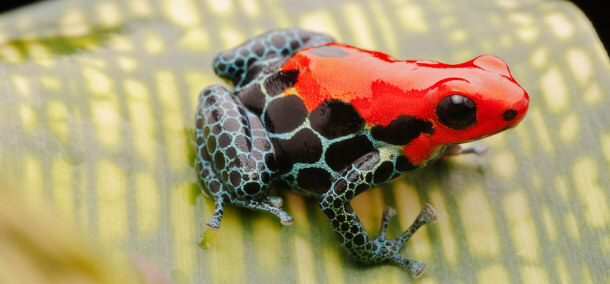
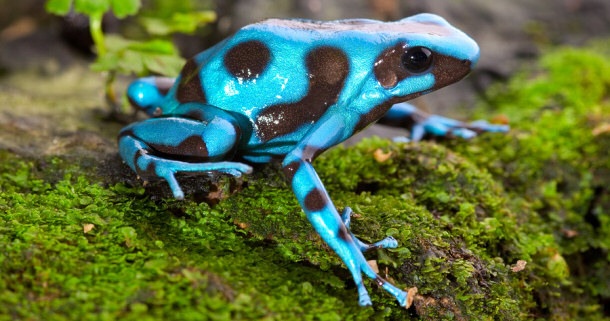
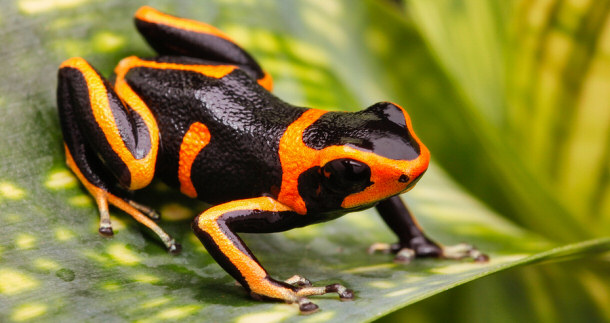
4) The Painful Bullet Ant
Nat Geo calls the bullet ant the world’s largest ant,
and say it grows to the size of an adult human pinky finger. This ant not only
has a very painful bite, but it also stings like a wasp. This horrifying
creature is solitary in the daytime, but it lives in a colony (usually like a
nest) at the base of trees. No one is certain where the name comes from, but the
pain of the ant's bite is well-known. It takes 24 hours for the pain to begin to
subside. Mother Nature Network says the Schmidt Sting Pain Index shows the
bullet ant delivers the most painful sting in the insect world. Despite this
knowledge, some tribes in South America require men to endure stings from these
animals as a rite of passage- sometimes up to 20 times consecutively. Women do
not have to undergo this torture, though. The stings are not deadly and leave no
permanent damage, but they can cause soreness for weeks after.
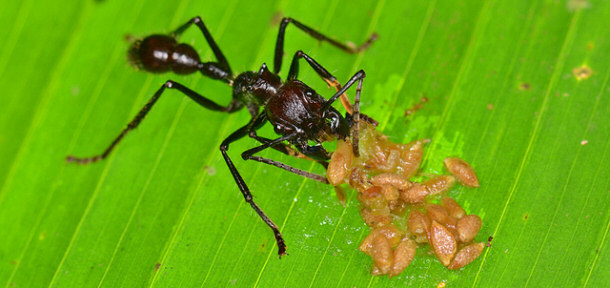
3) The Elusive and Enigmatic Kagu
The Kagu, a rare bird found in New Zealand,
has rather large wings, but it is flightless. The BBC says it lives in the
forest, but it has light coloration, which does not help it blend well. It has
nasal coms, one-third the red blood count of other birds, and is about the size
of a chicken. The San Diego Zoo says the bird has "gray feathers, bright orange
legs and bill, head crest like a cockatoo’s, and bold stripes on its wingtips."
It has waterproof feathers that protect it from being soaked in its naturally
wet habitat and the animal can run quickly, which helps make up for its lack of
flight. They have a pointed, strong bill that is excellent for digging, and
strong eyesight from dark red eyes. When hunting fish or insects, the bird can
stand still for long periods of time on one leg, and it strikes quickly when
food is found. Its wings are good for making the bird appear larger and more
threatening so that it can protect its young chicks from predators. It will also
let out a frightening shriek when it feels threatened. Other than that, not much
is known about the birds, except that very few exist due to over poaching for
its feathers to wear in ladies' hats in the 1800s.
2) The Rare Striped Rabbit
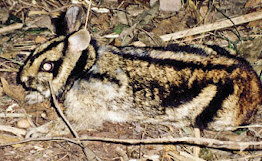 In the last decade, scientists made a great discovery
and it's one that has left many people scrambling for pictures of the rare
creature. The striped rabbit (also known as the Sumatran rabbit) is considered a
scientific novelty thanks to its unusual appearance. Native to a certain region
in Burma (Sumatra, where the miniature deer was also recently discovered),
pictures of this animal are scarce. It's larger than most rabbits, Live Science
and Nat Geo both say, and nocturnal. In 2011, night vision cameras caught
several snapshots of one, showing the creature's signature short ears and wide,
dark stripes that adorn its face and body. They were first photographed for the
first time in 1998, but not many sightings of them have since been made. They
were once on the endangered species list, but are not now. It is not known what
prompted this change or if their population numbers have really improved. In the last decade, scientists made a great discovery
and it's one that has left many people scrambling for pictures of the rare
creature. The striped rabbit (also known as the Sumatran rabbit) is considered a
scientific novelty thanks to its unusual appearance. Native to a certain region
in Burma (Sumatra, where the miniature deer was also recently discovered),
pictures of this animal are scarce. It's larger than most rabbits, Live Science
and Nat Geo both say, and nocturnal. In 2011, night vision cameras caught
several snapshots of one, showing the creature's signature short ears and wide,
dark stripes that adorn its face and body. They were first photographed for the
first time in 1998, but not many sightings of them have since been made. They
were once on the endangered species list, but are not now. It is not known what
prompted this change or if their population numbers have really improved.
1) The Glass Frog
The glass Frog is not really made of glass. National
Geographic and BBC say the frog gets its name from it translucent abdomen. This
frog is mostly lime green, but it can come in other shades, rarely. Its belly
and sometimes parts of the back are see-through, revealing their internal
organs. They are forest creatures that live almost exclusively, so their
coloration allows them to blend into the leaves. There are currently 134 species
of glass frogs, and all range between 1.4 and 3 centimeters. Out of those, 60
species are considered threatened, even though it is the most common species in
Central and South America. The Rain Forest Alliance said the frog has small,
yellow suction pads on its fingers and toes, a short snout, and gold irises. The
glass frog is nocturnal only venturing out at night to hunt and search for a
mate. When mating, males will emit a very recognizable call that will increase
in volume as they become older and surer of themselves. The frogs will lay 18-30
eggs at one time near water and the males will guard the eggs and keep them
moist until the tadpoles hatch and drop into nearby water. They are found
throughout Central and South America.
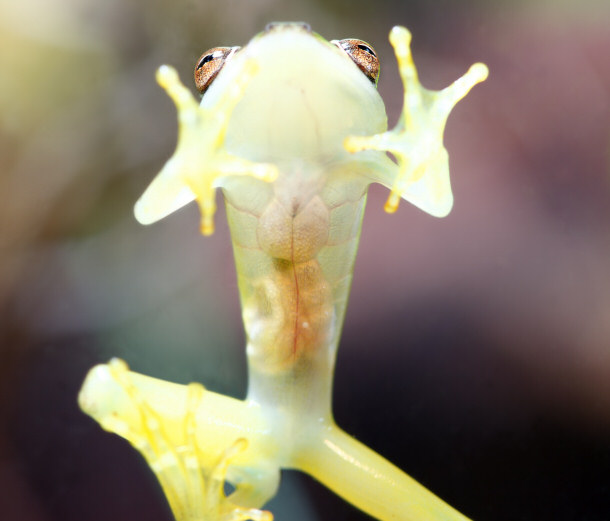
Final Words
Whether it is the fascinating or grotesque, the unique or the weird, there
are some amazing animals in the world's forests. Most are endangered thanks to a
number of reasons: climate change, poaching, and habitat erosion are some of the
main issues killing out these amazing animals. The hideous looking Aye-aye, the
regal looking Tamarin, the dangerous bullet ants and dart frogs, and even the
cuddly Red Pandas are all on the endangered species lists. Although conservation
efforts have begun for each of these, it may be too late to save some and future
generations will have to learn about these unique forest creatures form science
books.
Nature
Top Lists:
15 Fascinating Facts about the Amazon Rainforest
15 Remarkable Facts About Bacteria
15 Remarkable Facts About Jellyfish
15 Little Known Facts About Elephants
15 Fascinating Facts about Earthquakes
15 Odd And Interesting Facts about Monkeys
Top 15 Myths about Snakes
Top 15 Myths about Horses
Top 15 Creepy Deep Sea Creatures
15 Unexpected Animals That Can Kill You Quickly
Top 15 Spider Myths
15 Beautiful Animals that are Now Extinct
Top 15 Most Amazing Snakes Around the World
15 Fascinating Facts about Snow
Top 15 of the World's Rarest Flowers
10 Most Emotional Animals
15 of the Most Venomous Creatures to Roam the Earth
15 Unusual Animal Defense Mechanisms
15 Unusual and Less Known Uses of Rocks
15 Unique Forest Creatures Less Known To Man
15 Interesting Facts About Time
15 Unknown Parasites You Never Knew Existed
15 Weird Trees Around The World
15 Wild Animals Deadly to Humans
15 Exotic Insects That Are Harmful & Deadly
15 Ridiculous Uses for Gold
Informational:
Preparing for a Disaster
Proof That We Are What We Are!
What is the Meaning of Life?
The Trend and Challenges Facing the Urban World
Creation Narratives and the Evolution Creationist Debate |